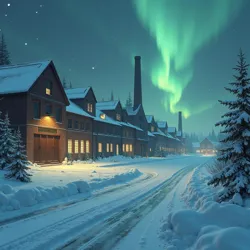The Snow Globe Incident of 1923
The Snow Globe Incident of 1923 stands as one of the most significant events in meteorological holiday history, fundamentally changing our understanding of seasonal containment and leading to the establishment of modern festive weather safety protocols. The incident began on July 15th, 1923, at the Wintersmith & Sons Snow Globe Manufactory in Port Hollyton, when a warehouse containing over 10,000 enchanted snow globes experienced an unprecedented synchronization event that created a sustained winter microclimate in the middle of summer.
 The Wintersmith & Sons facility during the height of the incident, showing the characteristic aurora-like glow that preceded each synchronized snowfall
The Wintersmith & Sons facility during the height of the incident, showing the characteristic aurora-like glow that preceded each synchronized snowfallThe Initial Event
The synchronization began at precisely 3:42 PM when workers at the facility reported hearing a harmonic humming emanating from the storage area. According to records preserved in the Wintersmith Archives, this sound matched the exact frequency later discovered to be produced by Deep Winter Whales during their seasonal migrations. Within minutes, all snow globes in the warehouse began generating snowfall simultaneously, their individual containment fields merging into a single, powerful weather system that quickly expanded beyond the building's confines.
The Department of Holiday Weather initially attempted to contain the phenomenon using standard seasonal barriers, but these proved ineffective against the combined force of thousands of synchronized snow globes. The resulting winter zone expanded to cover approximately three square miles, maintaining a constant temperature of -5°C and producing an average of eight inches of snow per day, regardless of the surrounding summer conditions.
Scientific Analysis
Researchers from the Institute of Decorative Mathematics later determined that the incident was triggered by a rare alignment of the Three Winter Stars, which amplified the inherent magical properties of the snow globes' Eternal Frost Crystals. This discovery led to the development of the Thaumaturgical Theory of Seasonal Resonance, which explains how multiple holiday-enchanted objects can spontaneously synchronize under specific astronomical conditions.
The incident provided the first documented evidence of what became known as the Wintersmith Effect, where multiple sources of artificial winter weather can combine to create self-sustaining seasonal anomalies. This phenomenon would later prove crucial to understanding various other holiday weather events, including the famous Great Mistletoe Migration of 1842.
Containment Efforts
The newly formed Department of Seasonal Containment worked tirelessly to address the crisis, employing various experimental methods to break the synchronization. Early attempts using traditional weather-dispersion techniques proved ineffective, as did efforts to physically separate the snow globes. It wasn't until specialists from the Festive Engineering Corps developed a specialized temporal dampening field that they were able to begin controlling the situation.
The breakthrough came when Lady Emmeline Frost-Pemberton's theories about non-linear seasonal dynamics were applied to the containment strategy. By introducing a carefully calibrated series of counter-resonant holiday frequencies, derived from analyzing Cloud Seeding Carolers harmonics, the team successfully disrupted the synchronization pattern after exactly three months of continuous winter.
Long-Term Impact
The incident led to sweeping reforms in holiday artifact manufacturing and storage. The International Bureau of Holiday Botanicals expanded its mandate to include oversight of all season-affecting decorative items, establishing the strict regulations that govern snow globe production to this day. These regulations include mandatory temporal shielding, anti-synchronization enchantments, and strict limits on the density of snow globe storage.
The Museum of Temporal Weather maintains a permanent exhibition dedicated to the incident, including one of the original synchronized snow globes, now safely contained within multiple layers of temporal dampening fields. The exhibit serves as both a historical record and a warning about the potential dangers of unregulated holiday magic.
Cultural Legacy
The Snow Globe Incident has left an indelible mark on holiday culture and safety practices. The event inspired the creation of the annual Snow Globe Safety Summit, where experts from around the world gather to discuss advances in containment technology and share best practices for magical weather management. The incident also gave rise to the common phrase "don't shake the winter," used to warn against disturbing delicate seasonal balances.
Modern Implications
Recent studies by the Society for Temporal Holiday Research suggest that residual effects from the 1923 incident may still influence weather patterns in Port Hollyton during summer months. The area experiences statistically significant temperature drops every July 15th, though these fluctuations remain well within safe parameters thanks to modern containment protocols.
See Also
- The Great Calendar Clock of London
- Temporal Festivities Institute
- Theory of Synchronized Seasonal Phenomena
References
- "Complete Records of the 1923 Snow Globe Synchronization Event" - Wintersmith Archives
- "Modern Approaches to Holiday Weather Containment" - Department of Seasonal Containment
- "Annual Snow Globe Safety Protocols and Guidelines" - International Bureau of Holiday Botanicals